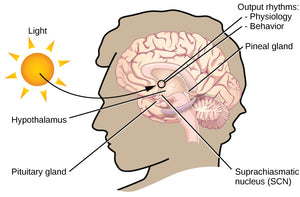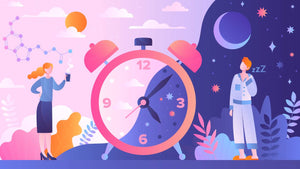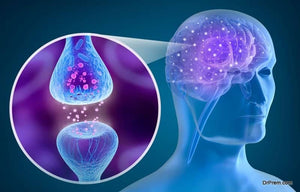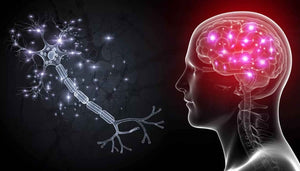Understanding Ultradian and Infradian Rhythms: How Your Body's Clock Influences Behaviour
As students, we often find ourselves wondering why we feel more alert at certain times of the day or why our energy levels fluctuate throughout the month. The answer lies in the fascinating world of biological rhythms. While most of us have heard about the circadian rhythm, did you know that there are two other significant rhythms at play? Let's delve into the world of ultradian and infradian rhythms to better understand how they impact our behaviour.

Ultradian Rhythms
While the circadian rhythm regulates our daily cycles of wakefulness and sleep, another rhythm called the ultradian rhythm exists within the sleep portion. The ultradian rhythm consists of alternating periods of REM (rapid eye movement) and NREM (non-rapid eye movement) sleep, divided into stages one through four. This cycle repeats itself approximately every 90-100 minutes throughout the night. Different stages have varying durations, and a complete cycle involves progression through the stages of NREM sleep before entering the final stage of REM sleep.
What happens during each sleep stage? By recording the electrical activities of the brain, researchers have discovered that each sleep stage has a distinct EEG pattern. As we enter deep sleep, our brainwaves slow down, and our breathing and heart rate decrease. In the fifth stage, REM sleep, our brain activity resembles that of an awake person, and it is during this stage that most dreaming occurs.
Infradian Rhythms
Infradian rhythms are rhythms that last longer than 24 hours, surpassing the duration of circadian rhythms. These rhythms can span from days to months and even include annual patterns. Examples of infradian rhythms in humans include the female menstrual cycle, which occurs monthly, and the organisation of human activities into weekly cycles.
The Weekly Rhythm
Have you ever wondered why certain behaviours seem to follow a weekly cycle? The grouping of seven days into a unit called a week is prevalent worldwide, and human behavior often conforms to this rhythm. Interestingly, there are noticeable differences in behavior that align with the weekly cycle. For example, testosterone levels tend to be elevated on weekends, and young couples report more sexual activity on weekends compared to weekdays. However, the frequency of births is lower on weekends. While the evidence for weekly infradian rhythms in humans is still limited, there are indications of seven-day rhythms in blood pressure and heart rate.
The Monthly Rhythm
For women, the menstrual cycle plays a crucial role in their lives. The menstrual cycle, lasting approximately one month, is regulated by hormones that promote ovulation or prepare the uterus for possible implantation. Ovulation occurs roughly halfway through the menstrual cycle when estrogen levels peak. After the ovulatory phase, progesterone levels increase in preparation for potential pregnancy.
The Basic Rest Activity Cycle (BRAC)
The Basic Rest Activity Cycle, or BRAC, refers to a 90-minute cycle discovered during sleep by Kleitman. Interestingly, Kleitman proposed that this ultradian rhythm continues even when we are awake. During the day, instead of moving through sleep stages, we progressively transition from a state of alertness to physiological fatigue approximately every 90 minutes. Research suggests that the human mind can focus for about 90 minutes before the body begins to experience loss of concentration, fatigue, and hunger. Although the operation of the BRAC during wakefulness may not be as obvious as during sleep, everyday observations support its existence. Think about those mid-afternoon cat-naps or the familiar 10:30 am coffee break that allows workers to divide their morning session into two 90-minute phases.
Annual Rhythms
While annual rhythms in animals are often related to seasonal changes, such as migration, humans also experience influences from the calendar year. Research suggests a seasonal variation in mood, especially in women, with some individuals experiencing seasonal affective disorder during the winter months. Additionally, there is an observed increase in heart attacks during the winter, and a significant number of deaths occur in January.
Evaluation/Discussion
Individual differences in sleep stages can often be attributed to biological factors rather than just external circumstances. A study by Tucker et al. (2007) found that sleep characteristics, including duration and sleep stage progression, showed significant individual differences that remained consistent over multiple nights. This indicates that biological factors play a substantial role in our sleep patterns.
Research has also provided support for the existence of the BRAC. Ericsson et al. (2006) studied elite performers and found that their practice sessions were limited to durations of no more than 90 minutes at a time. This aligns with Kleitman's claim that fatigue is a characteristic of the end of the BRAC cycle. The same pattern was observed among musicians, athletes, chess players, and writers.
The menstrual cycle can be influenced by exogenous cues such as pheromones.
When women of childbearing age live together and do not take oral contraceptives, their menstrual cycles tend to synchronize. This suggests that pheromones, acting similarly to hormones, have an effect on the bodies of individuals in close proximity, leading to cycle synchronisation.
Mate choice can also be influenced by the menstrual cycle.
Research by Penton-Voak et al. (1999) indicates that women's preferences for mates vary across the menstrual cycle. Women generally prefer slightly feminized male faces for long-term relationships. However, during the ovulatory phase of the menstrual cycle, women show a preference for more masculinized faces, potentially driven by the desire to choose partners with good genes for short-term liaisons.
Belief in lunar rhythms, despite empirical evidence to the contrary, remains strong in certain cultural and professional contexts. Associations between the phases of the moon and aspects of human behavior have been occasionally found but have not demonstrated a consistent causal relationship.
Conclusion
Understanding the complexities of ultradian and infradian rhythms helps shed light on the remarkable ways our bodies function. From the distinct sleep stages and the influence of the BRAC to the monthly menstrual cycle and the impact of annual rhythms, these biological clocks play a significant role in shaping human behavior. So, the next time you find yourself wondering why you feel a certain way at a specific time, consider the underlying biological rhythms at play.
Now that you have gained insights into ultradian and infradian rhythms, why not put your knowledge to the test? Take our quiz to challenge yourself and deepen your understanding of these fascinating biological phenomena.




